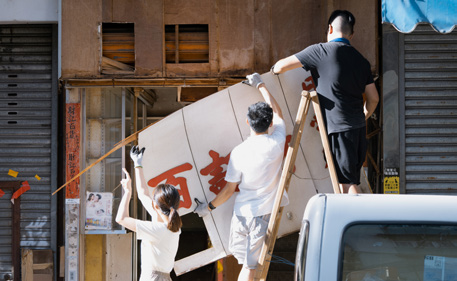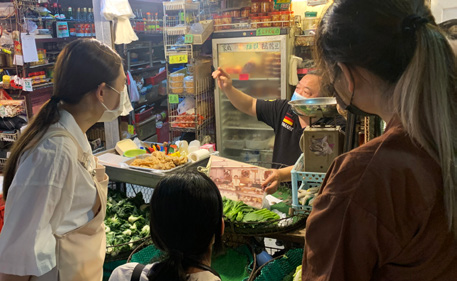To Kwa Wan, an urban district in Central Kowloon, has carved out a very unique cultural landscape with a rich history, ethnic diversity, and many community stories.

In the face of demolition in To Kwa Wan, Community Cultural Concern works to
rebuild community spirit and uphold community values.
A House of Stories, Face to Face
To Kwa Wan is home to new and old immigrants, ethnic minorities, and experienced artisans and young artists alike–many residents have known each other for a generation or more. For decades, there were few large shopping malls and chain stores, and it was smallness that thrived–shops, workshops, and walk-up low-rise residential buildings.
The community has been populated for thousands of years: about ten years ago, 10th century wells and hundreds of historical relics were excavated when a new subway line was underconstruction. Still, To Kwa Wan was not protected from high-speed redevelopment, and the impact has been irreversible. Shops that had served the community for 50-plus years were vacated, and homes that have seen generations grow up have been replaced by luxurious highrises.
Community Cultural Concern (CCC) has been working with affected neighbourhoods since 2013, before the bulldozers came, hoping to maintain the community’s historical and cultural identity. CCC believes that locals are not victims of the so-called ‘urban development’, but agents for change. Their public space The House of To Kwa Wan Stories has been pivotal in their approach–the centre has published stories of a local auto repair shop, oil dealer, hardware shop, and a Chinese herbal clinic, and hosted events such as a community kitchen and community market. Locals also offer instruction here, sharing their expertise on embroidery, making lanterns, the Urdu language, and more. With stories being shared and locals seeing more of each other, a sense of community is returning.
Over the years, CCC has been building community relationships through cultural interventions. Since 2020, PCD has been supporting its Face Project, encouraging To Kwa Wan locals to meet each other face-to-face. The project involves courses, raising awareness on local shops, and small grants. Ten locals have been teaching courses ranging from Indian cuisine to traditional Chinese snacks to making bronze signage, with about 15 locals joining each course. People are gradually rebuilding their confidence, recognising their skills,and taking interest in passing on community culture. To Kwa Wan is once again becoming close-knit, ready to face any challenges ahead.

In the Face Project, youth facilitate local shopkeepers to
tell their life stories which are documented.
Stores Hold Stories
In 2022, CCC launched an initiative to acknowledge and raise awareness about local To Kwa Wan shops: 25 enthusiastic youth with varied occupational backgrounds were selected to participate, collecting and documenting stories. Staff introduced the shops and trained the participants in community research, while external instructors shared documentation methods such as oral history, illustrated books, and community arts and also taught principles and skills of community building. One facilitator said, “Community building is about what happens in a place on a daily basis, and forging connections between seemingly unrelated things and happenings.”
The young participants began to rediscover their community as they observed, listened to, and recorded stories. The tea shop story speaks of how food and language help women from mainland China engage with locals of various backgrounds. The auto repair shop story reveal show the sector evolves with and shapes To Kwa Wan culture. Other stories draw public attention to urban redevelopment. As the shop-owners have shared their life stories with the youth, the two groups have become more connected, and the value of the shops more deeply acknowledged by the community.
To showcase the value of community culture, CCC held experiential workshops, exhibitions and courses for To Kwa Wan locals and the public alike. Small grants supported local instructors, shops, and youth to host cultural events.
CCC was not exempt from the redevelopment. They lost their base and their networks with nearby locals, and they too had to rebuild connections with new neighbours. In fact, they implemented the Face Project during their relocation–a trying time! Yet, change can bring opportunity, and when staff met young artists and designers who were also new to the area, they’ve sensed a synergy to work together. ‘The Community Lives On’ reads a banner at The House of To Kwa Wan Stories–landscapes and relationships may change, yet history and culture live on.
Passion and creativity will continue to connect people with their community.

